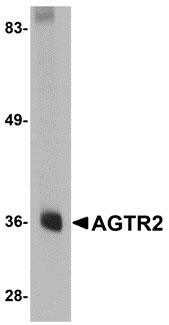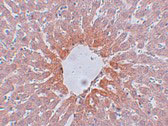AGTR2 Antibody
- SPECIFICATION
- CITATIONS
- PROTOCOLS
- BACKGROUND

Application
| WB, IHC-P, E |
|---|---|
| Primary Accession | P50052 |
| Other Accession | AAS45437, 42766665 |
| Reactivity | Human, Mouse, Rat |
| Host | Rabbit |
| Clonality | Polyclonal |
| Isotype | IgG |
| Calculated MW | Predicted: 40 kDa Observed: 36 kDa |
| Application Notes | AGTR2 antibody can be used for detection of AGTR2 by Western blot at 0.5 µg/mL. Antibody can also be used for immunohistochemistry starting at 5 µg/mL. |
| Gene ID | 186 |
|---|---|
| Target/Specificity | AGTR2; |
| Reconstitution & Storage | AGTR2 antibody can be stored at 4℃ for three months and -20℃, stable for up to one year. As with all antibodies care should be taken to avoid repeated freeze thaw cycles. Antibodies should not be exposed to prolonged high temperatures. |
| Precautions | AGTR2 Antibody is for research use only and not for use in diagnostic or therapeutic procedures. |
| Name | AGTR2 {ECO:0000303|PubMed:7790004, ECO:0000312|HGNC:HGNC:338} |
|---|---|
| Function | Receptor for angiotensin II, a vasoconstricting peptide (PubMed:28379944, PubMed:29967536, PubMed:31899086, PubMed:8185599). Signals primarily via a non-canonical G-protein- and beta-arrestin independent pathways (PubMed:28379944). Cooperates with MTUS1 to inhibit ERK2 activation and cell proliferation (PubMed:15123706). |
| Cellular Location | Cell membrane {ECO:0000250|UniProtKB:P35374}; Multi-pass membrane protein |
| Tissue Location | In adult, highly expressed in myometrium with lower levels in adrenal gland and fallopian tube. Expressed in the cerebellum. Very highly expressed in fetal kidney and intestine |

Thousands of laboratories across the world have published research that depended on the performance of antibodies from Abcepta to advance their research. Check out links to articles that cite our products in major peer-reviewed journals, organized by research category.
info@abcepta.com, and receive a free "I Love Antibodies" mug.
Provided below are standard protocols that you may find useful for product applications.
Background
AGTR2 Antibody: Angiotensin II is a potent vasopressor hormone and a primary regulator of aldosterone secretion that acts through at least two types of receptors, AGTR1 and AGTR2. It is an important effector controlling blood pressure and volume in the cardiovascular system and plays a major role in the development of the mammalian kidney and urinary tract. Like AGTR1, AGTR2 is a seven transmembrane G protein-coupled receptor (GPCR), but AGTR2 does not demonstrate most of the classic features of GPCR signaling. AGTR2 is involved in a wide range of activities, including the induction of neurite outgrowth and the inhibition of cellular proliferation, in addition to the known function of mediation of vasoconstriction.
References
Mottl AK, Shoham DA, and North KE. Angiotensin II type 1 receptor polymorphisms and susceptibility to hypertension: A HuGE review. Gen. in Med. 2008; 10:560-574.
Miyazaki Y and Ichikawa I. Role of the angiotensin receptor in the development of the mammalian kidney and urinary tract. Comp. Biochem. Physiol. A Mol. Integr. Physiol. 2001; 128:89-97.
Laflamme L, Gasparo M, Gallo JM, et al. Angiotensin II induction of neurite outgrowth by AT2 receptors in NG108-15 cells. Effect counteracted by the AT1 receptors. J. Biol. Chem.1996; 271:22729-35.
Stoll M, Steckelings UM, Paul M, et al. The angiotensin AT2-receptor mediates inhibition of cell proliferation in coronary endothelial cells. J. Clin. Invest. 1995; 95:651-7.
If you have used an Abcepta product and would like to share how it has performed, please click on the "Submit Review" button and provide the requested information. Our staff will examine and post your review and contact you if needed.
If you have any additional inquiries please email technical services at tech@abcepta.com.













 Foundational characteristics of cancer include proliferation, angiogenesis, migration, evasion of apoptosis, and cellular immortality. Find key markers for these cellular processes and antibodies to detect them.
Foundational characteristics of cancer include proliferation, angiogenesis, migration, evasion of apoptosis, and cellular immortality. Find key markers for these cellular processes and antibodies to detect them. The SUMOplot™ Analysis Program predicts and scores sumoylation sites in your protein. SUMOylation is a post-translational modification involved in various cellular processes, such as nuclear-cytosolic transport, transcriptional regulation, apoptosis, protein stability, response to stress, and progression through the cell cycle.
The SUMOplot™ Analysis Program predicts and scores sumoylation sites in your protein. SUMOylation is a post-translational modification involved in various cellular processes, such as nuclear-cytosolic transport, transcriptional regulation, apoptosis, protein stability, response to stress, and progression through the cell cycle. The Autophagy Receptor Motif Plotter predicts and scores autophagy receptor binding sites in your protein. Identifying proteins connected to this pathway is critical to understanding the role of autophagy in physiological as well as pathological processes such as development, differentiation, neurodegenerative diseases, stress, infection, and cancer.
The Autophagy Receptor Motif Plotter predicts and scores autophagy receptor binding sites in your protein. Identifying proteins connected to this pathway is critical to understanding the role of autophagy in physiological as well as pathological processes such as development, differentiation, neurodegenerative diseases, stress, infection, and cancer.



